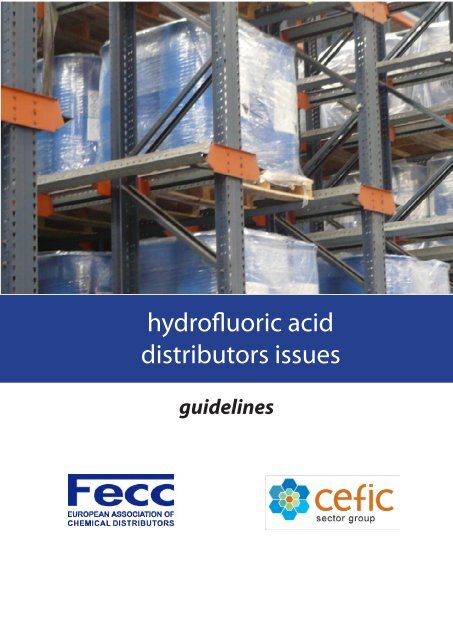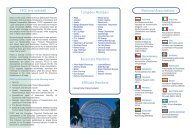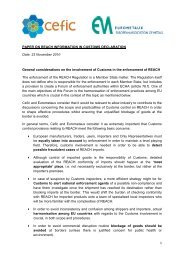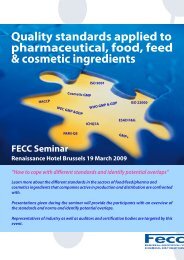Hydrofluoric Acid Distributors Issues Guidelines - Eurofluor
Hydrofluoric Acid Distributors Issues Guidelines - Eurofluor
Hydrofluoric Acid Distributors Issues Guidelines - Eurofluor
- No tags were found...
You also want an ePaper? Increase the reach of your titles
YUMPU automatically turns print PDFs into web optimized ePapers that Google loves.
hydrofluoric aciddistributors issuesguidelines
contentsIntroduction 3Information and training 6The task 3Site security 7Legal issues 3Glossary 8Risk assessment 3References 8Transport 4Guidance 8Storage 5DisclaimerThe information in the Guidance is given in good faith and belief in its accuracy at the time of publication, but it doesnot imply any legal liability or responsibility by the Fecc or the CTEF.The CTEF and Fecc do not, and indeed cannot, make any representation or give any warranty of guarantee in connectionwith material published in CTEF or Fecc publications and expressly disclaims any legal liability or responsibility fordamage or loss resulting from the use, or misuse, of information contained in this document.Users of this Guidance should pay regard to any relevant legislation or authoritative recommendations, which may haveevolved subsequently to the date of publication.This Guidance is not an authoritative interpretation of the Law, but if you do follow the Guidance, you will normally bedoing enough to comply with the Law. Similarly, Health and Safety Inspectors seeking to secure compliance with theLaw may refer to this Guidance as illustrating good practice.This Guidance is of voluntary nature each company may decide to apply it in full partly or not at all. In addition, thechoice of service provider by companies is based entirely on the individual decision-making of each company based onthis Guidance and / or their own criteriaCopyright Fecc– CTEF © 2010 Reproduction is authorised, except for commercial purposes, provided that the source ismentioned and acknowledged.2 www.fecc.org
introduction1.2.3.Hydrogen Fluoride (HF) is essential in thechemical industry and there is a need for HFto be produced, transported, stored and used.HF is a highly toxic and corrosive substance whichcan provoke acute and chronic poisoning (Detailedinformation can be found in the EU Risk Assessmentof Hydrogen Fluoride, 1999 1 ). As also described laterin this document HF exposures are different from otheracid exposures because HF penetrates all tissue itcomes in contact with and does not remain on theirsurface; and unlike other acids that are rapidly removedor neutralized, the corrosive and toxic effectsmay continue for days if left untreated. Precautionshave to be taken to ensure the safe handling of HF.The HF industry has a very good safety record; nevertheless,the European HF producers, organizedin CTEF 2 and the European Chemical <strong>Distributors</strong>acting within Fecc, have drawn up this documentto promote continuous improvement in thestandards of safety associated with HF handling.7.through a process that starts with risk assessment.Risk assessment in turn starts with a recognition ofthe hazards presented by any process, identifyingwho or what (e.g. the environment) may be affected,and to what extent, and putting in controls thatare adequate to eliminate or minimise those risks.Risk AssessmentRisk assessment is the systematic evaluation ofwork activities using the following five steps:Step 1:Step 2:Step 3:Step 4:Step 5:8.Identify the hazards.Identify the exposures. Who and whatcould be harmed and how?Evaluate the risks arising. Decide whetherexisting precautions are adequate or ifmore should be done.Record the findings.Review the assessment regularly and reviseif necessary.Advice on carrying out risk assessments is also containedin an UK HSE Guidance leaflet INDG163 4 .The Task4.The transport, handling and storage of <strong>Hydrofluoric</strong><strong>Acid</strong> (HF) within packages 3 , at any concentration arean area of concern for the distributors sector and CTEF.9.The remaining sections of this guidance help to identifymany of the hazards associated with the distributionof <strong>Hydrofluoric</strong> acid solutions, and give guidanceon how to reduce the risks. The assessor must ensurethat all relevant local factors are taken into account.5.•••The following issues are described:Transport infrastructureStorage infrastructureTraining and awareness10. It is important to set out the limitations of the riskassessment. A complete risk assessment will alsohave to consider other hazards, which are notwithin the scope of this guidance. The responsibilityfor ensuring a suitable and sufficient risk assessmentis carried out remains with the employer.Legal Duties6.Legal duties arise from many sources, and the referencescontain a number of the most relevant. For thepurpose of this guidance those duties may be summarisedas requiring safety to be actively managed11. The risk assessment should consider adjacent storage,including storage in other forms of packagingand/or bulk, as well as other classes of dangerousgoods and low hazard goods.It is recommended to have a risk assessment recorded.1http://ecb.jrc.ec.europa.eu/DOCUMENTS/Existing-Chemicals/RISK_ASSESSMENT/REPORT/hfreport002.pdf2CTEF – Comite Technique Européen du Fluor. www.eurofluor.org3Package goods, within the scope of these discussions, are containers with a capacity of 1000 Litres (Intermediate Bulk Containers (IBCs)) orlower.4http://www.hse.gov.uk/pubns/indg163.pdfwww.fecc.org 3
transportCarriers12. Due to the nature of the distribution industry withinEurope and the variations encountered within eachcountry the following “hierarchy of controls” for transportof <strong>Hydrofluoric</strong> <strong>Acid</strong> solutions in packages maybe identified:• Own fleet• Partner carriers• General carriers13. Each of the options within the hierarchy involves anincreasing degree of risk to be accounted for and theresponsibility to apply appropriate control measuresfor the movement to be undertaken lies with each organisation.It is for each company to decide based onits own criteria how best to be organised.Hierarchy of measures14. The use of ‘own drivers and own vehicles’ for <strong>Hydrofluoric</strong><strong>Acid</strong> deliveries is the preferred choice of manydistributors. This way companies could ensure internallythat the level of training and competence necessaryto safely transport HF is maintained throughoutthe journey.15. However, based on the distributor’s capacity and thelogistics required to service some remote locations,company fleets (if existing) will often be supplementedby a number of “partner carriers”. “Partner carriers”are chosen based on the individual decision-makingand internal criteria of each chemical distributioncompany.18. However, in some (exceptional) cases the need fortrans-shipment 5 of packages and/or use of other carriersmay be deemed necessary. In these cases the distributorshould make every effort to ensure that thesupply of information, training and material for FirstAid, including an antidote kit, is maintained throughoutthe journey.Description of Personal Protection Equipment(PPE) for drivers, including CalciumGluconate kitIt is highly recommended that:19. All drivers involved in the carriage of HF in packagesto be trained in Emergency First Aid including extratraining regarding the need for rapid application ofCalcium Gluconate gel.20. Speed and thoroughness in washing off the acid is ofprimary importance. Vehicles shall be provided withsufficient water, e.g. in a kind of extinguisher (minimum20 litres, the more the better).21. Vehicles carrying HF or sites containing HF shall haveimmediate access to emergency HF First Aid kit 6 , whichcontains a minimum of two tubes of Calcium Gluconategel 7 and if available a copy of the CTEF First AidBrochure 8 and the legally required documents (ADR/RID). These kits must be regularly audited to ensurethey are still suitable for use.Procedure for empty packaging16.It is strongly advised that these carriers are strictlycontrolled, audited and monitored to ensure that theyare:• Trained regarding the hazards• Trained regarding the extra First Aid necessary• Arrive at depots for collection with the correctequipment22. All transport and handling of ‘returnable or reusable’packaging for HF should be treated as if the containerswere full. All staff must be trained and have immediateaccess to HF first aid kits.Delivery to customers17. “Partner carriers” may, if applicable, be restricted tosingle trip deliveries.23. It is recommended for the distributor to have an accountset up with the customer that the material issold to. The material should be delivered to customersthat understand and have a good knowledge of therisks associated with handling HF.5Trans-shipment, within the scope of these discussions, is defined as the removal of packages from a vehicle for either:• Immediate reloading onto another vehicle; or• Storage overnight and then onward distributor the next day.6As an example, one of the options for an HF First Aid kit that could be applicable is detailed in the CTEF publication “Management of hydrofluoricacid injury (notes for Health Professional)” available on the website www.eurofluor.org7Preparation of Calcium Gluconate Gel is detailed in the CTEF publication “Management of hydrofluoric acid injury (notes for Health Professional)”available on the website www.eurofluor.org8CTEF First Aid Brochure is available in different languages on the website www.eurofluor.org4 www.fecc.org
storageIt is highly recommended that:24. Packaged HF to be stored within controlledsites to ensure the correct level of trainingand safety when handling the material. Thefollowing aspects should also be considered.Pallets25. The transport and storage of containers other than IBCs requirethe use of a “pallet” to allow the grouping of containers to aidhandling and prevent manual handling of numerous small containers.No storage at height, only on ground orfirst level28. The storage areas shall be secure external compounds,secure ground level or first level racked storagein warehouses. Adequate ventilation particularlyin warehouse storage is needed.26.27.<strong>Distributors</strong> can use wooden pallets for HF in containers butmust ensure that they have strict rigorous regimes in place to:• Use only high quality pallets• Check the integrity of the pallet to minimise the potentialof nail damageAs a desirable option, the use of ‘self-bunded’ plastic palletsshould be promoted.information & trainingIt is highly recommended that:Level Delta (δ) Personal Protective Equipment29. All <strong>Distributors</strong> implement rigorous control regimesfor the training of personnel who deal with HF withintheir organisations. All staff involved in the supplychain must be given training in hazard awareness sothey are informed as to the dangers involved with HF.30. CTEF has issued specific guidance, which providestraining recommendations for HF handling. Fecc andCTEF strongly recommend downloading the document‘STS 98/113 Training Recommendations for HFhandling’ or its replacing document ‘Group 7: Recommendationon safety management for handling ofAnhydrous Hydrogen Fluoride and <strong>Hydrofluoric</strong> <strong>Acid</strong>solutions’ from the website www.eurofluor.org.31. In the document STS 98/111 or its replacing documentGroup 7 some recommendations for ‘StandardEquipment’ (Level Delta (d)) can be found. Please referto the diagram on the right.First aid measures/planFecc and CTEF strongly recommend downloading the document‘STS 98/111 Personal protective equipment for use with HF’or its replacing document ‘Group 7: Recommendation on safetymanagement for handling of Anhydrous Hydrogen Fluorideand <strong>Hydrofluoric</strong> <strong>Acid</strong> solutions’ on website www.eurofluor.org.Delta Level is the minimum level of personalprotective equipment (PPE) requiredto enter an HF handling facilityand is not designed for use when thereis a risk of potential exposure to HF.Delta Level of PPE is specified whenthe risk assessment has indicated thatno physical contact with acid containingequipment is likely and, therefore,only minimal protection is needed. Itis intended to give protection againstpotentially small, unforeseen incidentse.g. drips, surface contamination, etc.Delta Level personal protective equipmentis defined as:• Standard hard hat.• Safety spectacles with side shields orchemical goggles.• HF resistant boots, overboots orsafety shoes with steel toe.• HF resistant gloves may also berequired.Escape air packs or suitable filtration systems should also be readilyavailable to enable an escape in the unlikely event of a leak.www.fecc.org 5
information & training32.<strong>Hydrofluoric</strong> <strong>Acid</strong> exposures are different from otheracid exposures because:• HF penetrates all tissue it comes in contact withand does not remain on their surface.• Once absorbed HF rapidly dissociates into ionicHydrogen and Fluoride.• Hydrogen is in this context of little importance,Fluoride migrates and continues to destroy deeptissue layers as it migrates and will create solubleand insoluble compounds that are the basis forthe systemic toxic effects.• Unlike other acids that are rapidly removed orneutralized, the corrosive and toxic effects maycontinue for days if left untreated.• In case of contact with HF, control or treatment bymedical personnel is needed.33. Hydrogen Fluoride is corrosive to the skin, eyes, andthe mucous membranes of the respiratory and digestivetracts. HF is readily absorbed into the body causingacute and severe toxic systemic effects, mainlyattributable to a rapidly developing serum hypocalcemiacaused by the formation of calcium fluoride orfluoroapatite, serum hypomagnesemia and serum hyperkaliemia.34. HF skin burns are usually accompanied by se-6 www.fecc.org
vere pain, which is thought to be due to irritationof nerve endings by increased level of potassiumions entering the extra-cellular space to compensatefor the reduced levels of calcium ions, whichhave been bound to the fluoride. Relief of pain is animportant guide for the success of the treatment;therefore local anaesthesia should be avoided.35. The extent and the intensity of these systemic complicationsare directly related to the amount of HFabsorbed, and the concentration of the HF when insolution. There are also indications that subcutaneousdeposits of HF under the burnt area may be responsiblefor a slow supply of fluoride ions to the circulation.36. Symptoms of serious intoxications include hypotension,hypocalcemia tetany, and/or laryngospasm,often-respiratory failure (possibly due topulmonary hypertension), ventricular tachycardia,ventricular fibrillation and cardiac arrest. Renaland hepatic functions may be impaired andmuscular damage may be secondary to tetany.37. Fecc and CTEF strongly recommend downloadingthe document ‘First Aid Brochure’ from the website:www.eurofluor.org38. All personnel involved in the physical handling of HF(Drivers, Fillers and warehouse staff) must be trainedin Emergency First Aid and then given extra trainingregarding the application of Calcium Gluconate gel.39. Speed and thoroughness in washing off the acid isof primary importance. Vehicles should be providedwith sufficient water, e.g. in a kind of extinguisher(minimum 20 litres, the more the better). Sites shall installa safety shower. Each shower should be capableof delivering approximately 100 litres of clean waterper minute for 15 minutes. Deluge initiation should besimple and rapid. The water supply pipe work shouldbe protected from frost (e.g. by insulation and/or tracesite securityheating). Additional sealed eye wash bottles containinga saline solution or clear water can be containedin suitable cabinets. Each cabinet should containabout one litre of solution and be regularly checkedto ensure their contents are up to standard.40. <strong>Distributors</strong> should offer hazard awareness training materialto customers who purchase HF and advise all customersto inform the local hospital that they handle thesubstance so they can plan for an incident.41. All organisations involved in the handling of HF eitherin filling or storage must have a written emergencyplan to ensure that effective treatment of HF contact isgiven immediately and that the local hospital is awareof the likelihood of an HF incident. All involved personnelshould be aware of this plan. Industrial experienceindicates that prompt treatment, as described, will preventthe development of serious injury. In the majorityof cases caused by industrial accidents, little more thanskin effects results after prompt treatment.42. Therefore, speed is essential. Delays in first aid careor medical treatment or improper medical treatmentwill likely result in greater damage or may, insome cases, result in a fatal outcome.43. Fecc and CTEF strongly recommend downloading thedocument ‘STS 94/96 <strong>Guidelines</strong> in case of HF Exposure’,where there are concise flowcharts detailing thecorrect treatment for each exposure route (skin, eyes,inhalation and ingestion). The document can be foundon the website www.eurofluor.org.44. High concentrations of hydrofluoric acid (above 60%)are classified for transport and assigned to packinggroup I of class 8. As such, these concentrations willfall within scope of the High Consequence DangerousGoods (HCDG) provisions of ADR chapter 1.10 and requiresecurity provisions.45. ADR 1.10 requires those involved in the transport ofHCDG to adopt, implement and comply with a writtensecurity plan. Local competent authority guidance onthese security plans may be available in Member Statesand may be subject to local enforcement inspections.46. Because of the hazardous nature of the chemical, distributorsare recommended to adopt aspects of sucha security plan for solutions of hydrofluoric acid below60%. As a minimum requirement, all solutions of HFshould be stored in a secure area with limited accessto trained personnel only.www.fecc.org 7
GlossaryHazard - That property of a material that has the potential to cause harm to people, property or the environment.Risk - The chance that somebody or something could be harmed by the hazards, together with an indication of how serious the harm couldbeIBC (for the purpose of this guide) - “Intermediate Bulk Container” (IBC) means a rigid or flexible portable packaging…. that:• has a capacity of not more than 3 m 3 for solids and liquids of packing groups II and III;• is designed for mechanical handling;• is resistant to the stresses produced in handling and transport as determined by the tests specified in Chapter 6.5 of ADRComposite IBC with plastic inner receptacle: These are IBCs comprising a rigid outer structure encasing a plastic inner receptacle.It is constructed so that the outer and inner assemblies are used as an integrated single unit to be filled, stored, transportedor emptied.References1. INDG163 - Guidance 5 Steps To Risk Assessment – ISBN-0-7176-6189-X2. The Carriage of Dangerous Goods and Use of Transportable Pressure Equipment Regulations3. ADR – European Agreement concerning the International Carriage of Dangerous Goods by Road – ISBN 92-1-139112-1Guidanceo CTEFNumber Publication title InfoFirst Aid BrochureManagement of hydrofluoric acid injury(notes for Health Professional) SecondEditionAvailable in seven languagesSTS 94/96 <strong>Guidelines</strong> in case of HF exposure Detailed Medical <strong>Guidelines</strong>Group 7STS 98/111STS 99/113Recommendations on safety managementfor handling of Anhydrous Hydrogen Fluorideand <strong>Hydrofluoric</strong> <strong>Acid</strong> solutionsPersonal protective equipment for usewith HFTraining Recommendations for HF handlingAvailable in 2010, replacing STS 98/111and STS99/113Available until mid 2010Available until mid 2010The European Chemical Industry CouncilCTEF | Comité Technique Européen du FluorAv. van Nieuwenhuyse 4/box11160 BrusselsBelgium+32 (0)2 676 73 72www.cefic.orgRue du Luxembourg 16B1000 BrusselsBelgium+32 (0)2 679 02 60www.fecc.org









